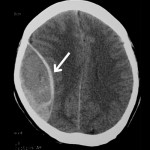This is the non-contrast CT (Figure 1) of a patient with an acute right-sided epidural haematoma ![]() . The skull vault is a tight space and the haematoma is causing significant mass effect, resulting in mid-line shift (the right cerebral hemisphere is shifted to the left as it can be seen crossing the mid-line). The epidural space is a potential space located between the inner surface of the skull and the tightly adherent periosteal dura. The middle meningeal artery, a branch from the external carotid artery, supplies the dura and runs along this space. Grooves, which are formed by this artery and its branches, can often be seen on the inner surface of the skull. Epidural haematomas are often caused by direct trauma to the skull, most often resulting in a laceration of the middle meningeal artery. Around 10% of epidural haematomas are venous, as a result of a skull fracture that crosses a dural venous sinus. Over 90% of epidural haematomas are unilateral and supra-tentorial. In most cases, the epidural haematoma is found adjacent to a skull fracture – the squamous portion of the temporal bone being the most common site. Epidural haematomas are typically biconvex or ‘lens-shaped’. This characteristic shape is because the periosteal dura is tightly adherent to the inner skull. As the epidural haematoma expands, it strips away the dura away from the inner skull, forming the characteristic lens-shape of the haematoma. Also, as the dura is tightly attached to sutures, epidural haematomas rarely cross suture lines. Most epidural haematomas are surgically evacuated.
. The skull vault is a tight space and the haematoma is causing significant mass effect, resulting in mid-line shift (the right cerebral hemisphere is shifted to the left as it can be seen crossing the mid-line). The epidural space is a potential space located between the inner surface of the skull and the tightly adherent periosteal dura. The middle meningeal artery, a branch from the external carotid artery, supplies the dura and runs along this space. Grooves, which are formed by this artery and its branches, can often be seen on the inner surface of the skull. Epidural haematomas are often caused by direct trauma to the skull, most often resulting in a laceration of the middle meningeal artery. Around 10% of epidural haematomas are venous, as a result of a skull fracture that crosses a dural venous sinus. Over 90% of epidural haematomas are unilateral and supra-tentorial. In most cases, the epidural haematoma is found adjacent to a skull fracture – the squamous portion of the temporal bone being the most common site. Epidural haematomas are typically biconvex or ‘lens-shaped’. This characteristic shape is because the periosteal dura is tightly adherent to the inner skull. As the epidural haematoma expands, it strips away the dura away from the inner skull, forming the characteristic lens-shape of the haematoma. Also, as the dura is tightly attached to sutures, epidural haematomas rarely cross suture lines. Most epidural haematomas are surgically evacuated.
- Figure 1
 HKU E-learning Platform in Clinical Neurosciences HKU eLearning Platform in Clinical Neurosciences
HKU E-learning Platform in Clinical Neurosciences HKU eLearning Platform in Clinical Neurosciences

